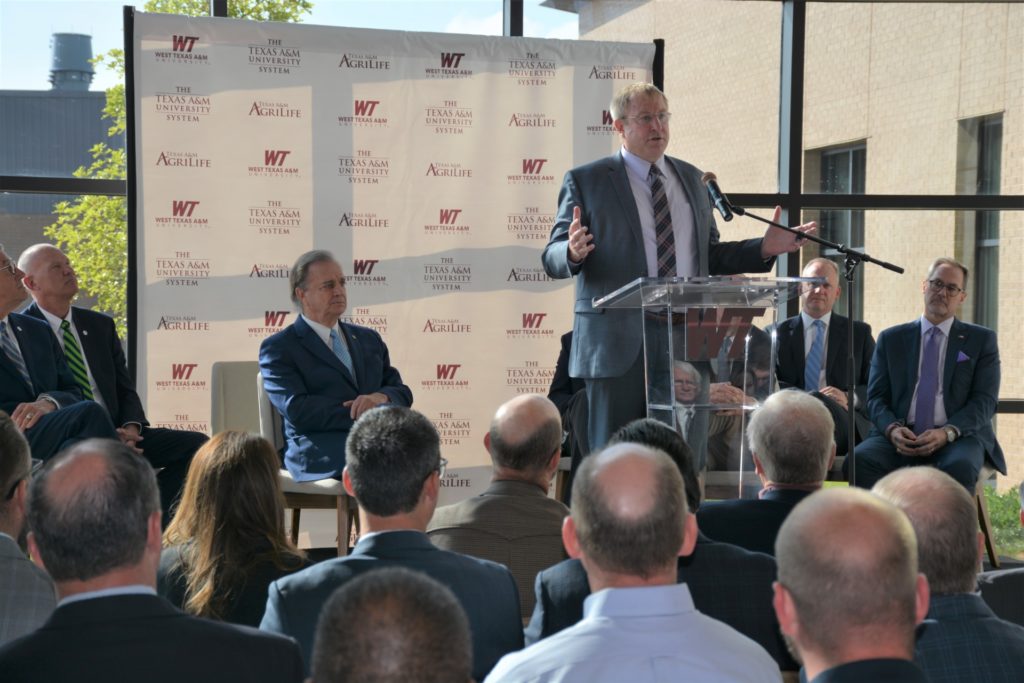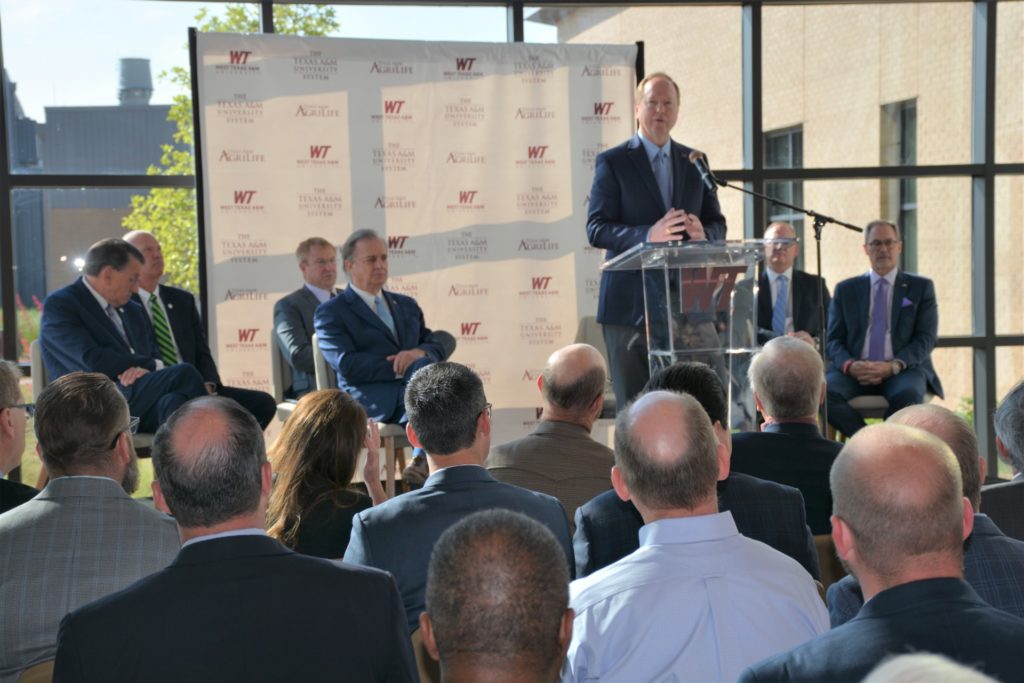Texas A&M AgriLife announces official move of facilities from Amarillo to Canyon
Building of new, $30 million home to AgriLife Research, AgriLife Extension to take place on West Texas A&M campus
The Texas A&M AgriLife Research and Extension Center of Amarillo will move to Canyon to complete an agricultural research, education and outreach powerhouse on the West Texas A&M University campus.

Funding for the new, $30 million center was approved May 19 by The Texas A&M University Board of Regents. Of that total, $20 million will come from the Permanent University Fund established by the state of Texas and $10 million from Texas A&M AgriLife Research and Texas A&M AgriLife Extension Service.
Chancellor John Sharp announced the move at a May 25 press conference in the Texas A&M Veterinary Education, Research and Outreach, VERO, building on the WT campus. The new facility will be constructed to the east of the Charles W. “Doc” Graham ’53 DVM, The Texas A&M University System Center, which encompasses VERO and the Charles W. Graham DVM Texas A&M Veterinary Medical Diagnostic Laboratory, TVMDL, building.
“We’re here today to announce something that only The Texas A&M University System could have accomplished. We’re bringing all of our resources together in one spot,” Sharp said. “We’re bringing together some of the best minds in agriculture together in collaboration right here in Canyon. This will be a real game-changer for agribusiness in Texas.”
Construction is expected to be complete in early 2024 at the northeast corner of the WT campus. The building will be home to about 60 employees working for the AgriLife Research and AgriLife Extension agencies.
Maintaining a strong Texas A&M AgriLife presence in the Panhandle
Texas A&M AgriLife has 13 centers around the state that house both AgriLife Research and AgriLife Extension personnel who support the districts and regions.

“Texas A&M AgriLife Research is headquartered in College Station, but we are an institution that serves the entire state of Texas, and our centers are imperative to making sure that each region of the state has research conducted in their unique environment,” said Cliff Lamb, Ph.D., director of AgriLife Research. “Here in the Panhandle, we look forward to expanding our research programs in beef cattle, small grains, environmental quality, natural resources, pest management, crop systems and bioenergy.”
AgriLife Research has led the nation in six of the past eight years in agricultural research expenditures, with more than $223.5 million for the fiscal year 2021, Lamb said.
“Much of that is dedicated to supporting Texas commodities, reflecting our agency’s dedication to producers and ensuring a thriving industry across Texas,” he said.

Rick Avery, Ph.D., director of AgriLife Extension, said the Texas A&M AgriLife Research and Extension Center at Amarillo has a long history of service and showcases the importance of the AgriLife mission—creating solutions to agriculture and natural resource issues through state-of-the-art research, and then ensuring that information is helpful and extended to the great state of Texas.
“This center has been instrumental in making a positive impact on the success of ag producers, on the youth in the Panhandle, and in increasing the health of our public,” Avery said. “This center is the home for professional development for our AgriLife Extension county agents and other key educators and specialists to learn the latest technology, best practices and methods that improve the lives of Texans.
“Additionally, this center serves as the primary location for agriculture producers, county judges and commissioners, and industry leaders to interact with AgriLife Extension personnel. Together, we are dedicated to creating solutions for a changing world, where agriculture and health are more important than ever.”
Complementing the university’s agricultural focus
WT President Walter V. Wendler said the move complements West Texas A&M University’s sincere focus on agricultural issues across the Texas Panhandle and beyond.
This new building on Russell Long Boulevard will be clustered with the VERO building; the TVMDL building; and the WT Agricultural Sciences Complex, which contains the Happy State Bank Academic and Research building, the Caviness Meat Science and Innovation Center, the Piehl-Schaeffer Pavilion and the Bain Event Center.
“What The Texas A&M University System Board of Regents have created on this campus is unparalleled in regional higher education across the country,” Wendler said. “The opportunities made possible by this partnership will advance the research and outreach missions of all of our institutions.”
The move further cements WT as a regional research university, the overarching goal of its long-range plan, WT 125: From the Panhandle to the World.
That plan is fueled by the historic, $125 million One West comprehensive fundraising campaign. To date, the five-year campaign — which publicly launched Sept. 23 — has raised about $110 million.
Synergy for education, extension and research
Brent Auvermann, Ph.D., center director for the facility at Amarillo, said AgriLife Research and AgriLife Extension will be strengthened by the synergy that is built upon the expertise, organization, programming, educational outreach and student involvement due to the proximity of both facilities and personnel.
“We expect to have greater exposure to the graduate and undergraduate students that WT has because we rely on them so heavily for our programs,” he said, estimating about 40 students are already being supervised by AgriLife Research and AgriLife Extension faculty at any time.
Additionally, Auvermann said the co-location of AgriLife Research’s globally recognized program will help build WT’s agricultural research portfolio.
“Our programs are built and sustained by external contracts and grants,” he said. “We’ve built tremendous momentum bringing those resources to the Panhandle, and we want to leverage them to accelerate the development of WT’s research portfolio while we enrich the educational experiences of her students.
“That synergy happens best when we are across the wall, around the corner, or just down the sidewalk from one another. We want to build a true community of practice, and we need to be face-to-face to accomplish that.”
Auvermann said putting all of these closely related organizations right next to one another tightens the integration of Texas A&M AgriLife’s land-grant mission with WT’s educational and research missions.
“This building will be Texas A&M’s embassy in the Texas Panhandle,” he said. “We want the new Texas A&M AgriLife center in Canyon to be used for community outreach and extension education as well as cutting-edge research, just as our current facility is today,” he said.
At Amarillo, the Texas A&M AgriLife center each year hosts more than 3,500 individuals who complete nearly 11,000 contact hours of education.
“We will continue to host events, provide outreach and advance science and engineering in support of Panhandle agriculture. We’ll just be doing it better,” Auvermann said.


